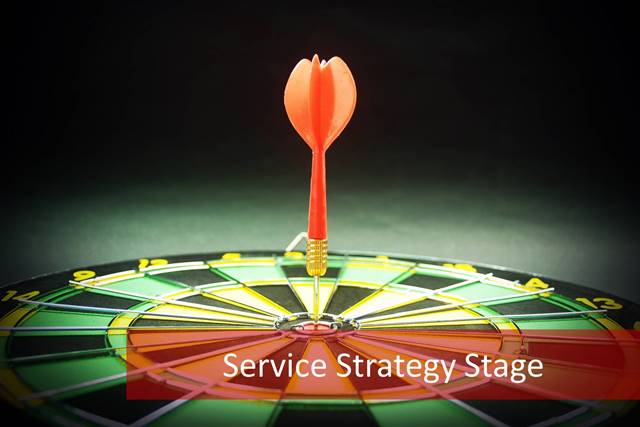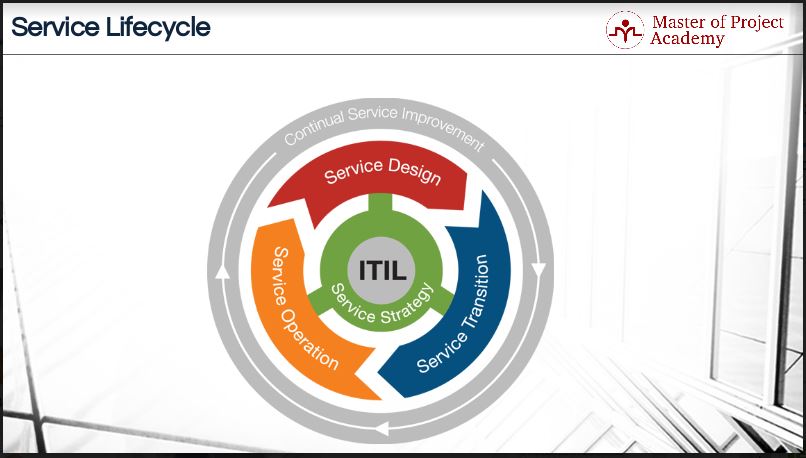The ITIL Foundation Certification Training Course discusses the ITIL Service Lifecycle. It shows that the Service Strategy stage is the first step in the ITIL Service Lifecycle. The Service Strategy Stage includes guidelines for design, development, and implementation of Service Management. The Service Strategy stage guides the application of IT service strategies to ensure the organization meets its business objectives and strategies.

Service Strategy in the ITIL Service Lifecycle
Service Strategy is at the heart of the ITIL Service Lifecycle. The Service Strategy stage provides guidelines to support the other stages of the ITIL Service Lifecycle: Service Design, Service Transition, Service Operation and Continual Service Improvement. The IT Service Owner is responsible and accountable for the effective implementation of a service via the ITIL service lifecycle processes.

A service owner must complete the Service Strategy stage within the scope of the complete ITIL service lifecycle to ensure a better service management in the entire organization. The Service Strategy stage supports other stages of service lifecycle; it should support the implementation of a comprehensive strategy. You can learn more about effective service management in the ITIL Foundation Exams and ITIL Overview course
Role of Service Strategy in Developing Markets
One of the main objectives of an organization is improving its existence in current markets and expanding to new markets. The Service Strategy stage must be compliant with these strategies of the organization. Furthermore, the Service strategy stage links business objectives of the organization with the IT strategies. This includes the development of existing and new markets.
Service Assets and Service Catalogue as part of Service Strategy
Service assets and Service Catalogue are in the scope of the Service Strategy stage. A new business case may require new services or processes, new resource capabilities or that some services may need to be retired. This is where service assets and the service catalog, which includes all services and details of the services provided by an organization, is considered.
Controlling Costs and Risks in the Service Strategy Stage
The Service Strategy stage should assure that costs and risks are controlled. Controlling costs is critical as services that bring higher costs than value to its customers are not viable. In addition, if your service management strategy has risks, you should have proper risk management plans, actions and recovery steps in place. Therefore, the Service Strategy stage should assure controlling of costs and risks in service management.
Considering Competitors in the Service Strategy Stage
The Service Strategy stage should also include insights gained from the competition. If your organization is not the only service provider in the market, you should be aware of what your competitors offer as well as your strengths and weaknesses against your competition. Accordingly, you should plan strategies to deliver distinct and winning services that your competition or rivals cannot offer. This way your organization will dominate the market progressively.
The Service Strategy Stage and Business Objectives
After the business objectives of the organization are determined, IT strategies to reach business objectives should be developed. This includes the development of new services or processes that might be needed or retiring existing services are no longer aligned with the business objectives.

The Service Strategy Stage Aims at Providing Distinct Services
Your organization should be watching the competition and planning proper business strategies to survive in the market and to have a strong business in the market. Providing a distinct and strong service or product in the market that your rivals cannot provide to its customers is one of the key points to survive in the market. If a customer finds tailored, customized, valuable and appropriate services in your organization, you will be beating the competition. To do this, your strategies should support the creation of distinct, unique and valuable services for the customers.
Developing Value to the Customer in the Service Strategy Stage
The success of a service or product is measured by its value to the customer. Achieving value for the customer is an essential objective of the Service Strategy stage. If the services of an organization do not reflect any value to its customers, the organization will lose its presence gradually which may have detrimental effects in the long-term. Therefore, when generating strategies, ensuring a value for the customer should be the main objective.
Establishing a Business Case in the Service Strategy Stage
If a strategy does not serve to a business objective or business case, it will not deliver on expectations when implemented. Business objectives generated by business cases must be met. Therefore, consistent IT strategies ensure that the business objectives can be met. Can you imagine that your organization generated a strategy without a business case and delivering a service that your customers will rarely or never use? This is an inefficient and ineffective use of resources and budget. If a strategy does not serve to a business case, it will not deliver value to the customers.
In conclusion, the Service Strategy stage is an important function in the ITIL Service Lifecycle. Effective implementation will ensure that business objectives are met and that the organization’s IT services will be of value to the customer.

23 thoughts on “ITIL Service Strategy: Guide for Winning IT Services”
Comments are closed.